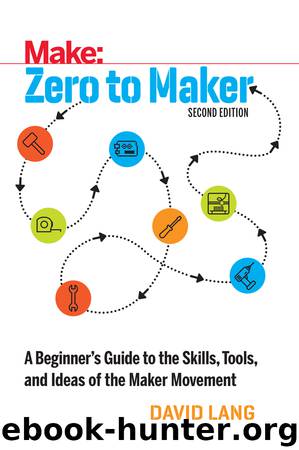Zero to Make by David Lang

Author:David Lang
Language: eng
Format: epub, mobi
ISBN: 9781680453386
Published: 2017-10-15T04:00:00+00:00
Craftsmanship Reimagined
Even though the past is still with us (and still valuable), that doesn’t mean that only traditional methods hold the mark of craftsmanship. I came to realize the concept was much broader. It didn’t necessarily equate to age or have to involve a specific method or technique. More than that, it was an ethic, a way of approaching the work.
In the moments of technological transition, when the boundaries between manual and mechanized labor begin to blur or change, an uneasy tension develops. Whenever machines start doing our “jobs,” a group of people revert to nostalgia for days and ways gone by, whereas others start tinkering with new opportunities, searching for a new maker aesthetic. The futurist Paul Saffo calls this the divide between the Druids and the Engineers (edge.org/response-detail/23858). It’s something I’ve struggled with myself as I met the torchbearers of traditional skills while at the same time reveling in the immediate feedback of the newer tools.
And the divide is nothing new. In American Genesis (University Of Chicago Press, 2004), Thomas Hughes’s account of technological innovation’s effect on American culture around the turn of the twentieth century, he describes the dynamic perspectives and outcomes from the previous industrial revolution:
With the rise of factory production and the displacement of human skills by machine, numerous social critics lamented the passing of the era of the craftsman. In England, William Morris celebrated the joy of work and called for the recovery of medieval crafts…. But in the industrial era tool users were giving way to machine tenders. Still, in the model rooms, laboratories, and machine shops used by independent inventors, craftsmen of a conspicuous skill thrived. Kruesi, with an intuitive grasp of Edison’s three-dimensional concepts, presided over the machine shop at Menlo Park. He transformed a quick sketch of Edison’s into the first phonograph…. Sperry attributed his company’s success in manufacturing the precision gyroscopic devices to the skill of his machinists, many of them Swiss.
My nostalgic sympathizing with the Tin Man (and many others) about the decline in skilled machinists and my own lack of manual literacy seemed eerily similar to the tone of William Morris. But looking back, even the skilled machinists once seemed a distasteful transition from what was considered good and fulfilling work. Similarly, the migration to the digital fabrication tools doesn’t spell the end of craftsmanship—rather an adaptation of it, driven by swaths of opportunity that the capital-intensive factory production model can’t serve efficiently.
If anything, the current trends of workmanship are pointing toward a more human-scale marketplace, a throwback to the small, local, and personal artisans and makers that existed before the factory production model took over. As people gain access to the powerful new tools of desktop prototyping and production, they are making everything they can imagine. And the new tools of distribution, fueled by the Internet and online communities like Etsy and Kickstarter, have made it easier than ever to connect and find a community of people to sell and share their wares.
Chris Anderson, the wisest
Download
This site does not store any files on its server. We only index and link to content provided by other sites. Please contact the content providers to delete copyright contents if any and email us, we'll remove relevant links or contents immediately.
| Automotive | Engineering |
| Transportation |
Whiskies Galore by Ian Buxton(41490)
Introduction to Aircraft Design (Cambridge Aerospace Series) by John P. Fielding(32857)
Small Unmanned Fixed-wing Aircraft Design by Andrew J. Keane Andras Sobester James P. Scanlan & András Sóbester & James P. Scanlan(32534)
Craft Beer for the Homebrewer by Michael Agnew(17902)
Turbulence by E. J. Noyes(7660)
The Complete Stick Figure Physics Tutorials by Allen Sarah(7097)
Kaplan MCAT General Chemistry Review by Kaplan(6548)
The Thirst by Nesbo Jo(6407)
Bad Blood by John Carreyrou(6245)
Modelling of Convective Heat and Mass Transfer in Rotating Flows by Igor V. Shevchuk(6207)
Learning SQL by Alan Beaulieu(5995)
Weapons of Math Destruction by Cathy O'Neil(5779)
Man-made Catastrophes and Risk Information Concealment by Dmitry Chernov & Didier Sornette(5593)
Digital Minimalism by Cal Newport;(5325)
Life 3.0: Being Human in the Age of Artificial Intelligence by Tegmark Max(5147)
iGen by Jean M. Twenge(5126)
Secrets of Antigravity Propulsion: Tesla, UFOs, and Classified Aerospace Technology by Ph.D. Paul A. Laviolette(4863)
Design of Trajectory Optimization Approach for Space Maneuver Vehicle Skip Entry Problems by Runqi Chai & Al Savvaris & Antonios Tsourdos & Senchun Chai(4807)
Electronic Devices & Circuits by Jacob Millman & Christos C. Halkias(4701)
